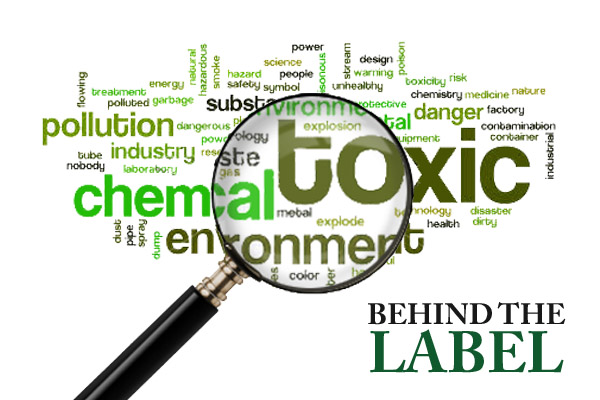Behind the Label: Johnson’s Baby Wash

Baby bath, baby oil, baby lotion, baby wipes. A quick skim of supermarket or pharmacy shelves and you could be forgiven for thinking that having a baby was more of an opportunity for niche shopping than a responsibility towards the future.
But there is ample reason to consider the bigger picture of baby toiletries and question whether all those three-for-twos that parents stock up on are really the bargains they appear to be. Consider the list of ingredients in the best-selling liquid soap for babies: Johnson’s Baby Softwash. Apart from the usual skin and eye irritants, this alarming mixture contains four ingredients that can be contaminated with the carcinogens 1,4 dioxane and ethylene oxide, two hormone disrupters linked specifically to breast cancer and several ‘penetration enhancers’ – chemicals that can increase the rate at which the body absorbs carcinogens and other harmful chemicals.
While it promises ‘baby-soft skin’, there is nothing in it that actually moisturises the skin, only synthetic polymers that coat the skin with a film-like substance giving the impression of smoothness. The rationale for using such chemicals is that they are washed off and therefore pose little risk. Indeed, in wash-off products manufacturers are allowed to use more of the chemicals that would otherwise be restricted in stay-on products. However, this argument may not ‘wash’ when it comes to infant skin.
Skin, the largest organ of the body, is both a crucial physical barrier and a significant route of absorption of toxic substances. Children’s skin is thinner and more absorbent than that of adults, so it provides a less effective barrier to environmental toxins. In addition, the fact that children are smaller in size than adults
means that their skin presents a larger surface area relative to their body weight for absorption of harmful substances.
In the developed world, the rates of eczema and allergies among children are on the rise. The early introduction of harsh toiletries onto sensitive skin may be a contributing factor to this. Unfortunately, parents whose children have skin rashes often approach the problem by piling on more synthetic goop, when cutting out baby toiletries entirely would be a more rational and effective solution.
Because women are leaving it later and later to have babies, many approach motherhood with more disposable income (and more ingrained buying habits). Manufacturers are keen to exploit this group of consumers by offering them so-called premium products. Johnson’s Baby Softwash is just such a product. The Johnson’s Baby slogan ‘best for baby, best for you’ reaches deep into the psyches of mums who have an ‘only the best for my baby’ attitude, but little time or inclination to examine just what ‘best’ actually means.
The Johnson’s Baby range of toiletries is the UK’s biggest selling brand taking a 43 per cent share of a baby toiletries and wipes market that is worth £100m. Worldwide, Johnson’s and Johnson’s products account for 31 per cent of the total baby-care market; their next closest competitors, Pantene, Nivea and L’Oreal, by comparison, account for only around 2 per cent each of the worldwide market. Johnson’s premium Softwash range, introduced in 2003, boosted the company’s total worldwide sales by a staggering 13 per cent.
Sidebar: What’s in it?
Sodium laureth sulfate
Purpose: Detergent
Adverse effects: Skin dryness. Eye irritation. Penetration enhancer. Laureth compounds can be contaminated with 1,4 dioxane: a carcinogen linked to breast cancer.
Cocamidopropyl betaine
Purpose: Detergent
Adverse effects: Skin and eye irritation. Penetration enhancer. Can be contaminated with diethanolamine, which when combined with formaldehyde (released by other ingredients during storage) produces carcinogenic nitrosamines (see polyquaternium 7).
PEG-150 distearate, PEG-80 sorbitan laurate, PEG-14 M
Purpose: Multiple, including thickener solvent, emulsifier and surfactant
Adverse effects: Penetration enhancer. Skin irritation. Peg-14M is considered unsafe to use on damaged skin. Can be contaminated with 1,4-dioxane and ethylene oxide, which are linked to breast cancer.
Polyquaternium-7
Purpose: Forms film on the skin that gives the impression of softness.
Adverse effects: Contact dermatitis. Formaldehyde releaser, thus a potential carcinogen. It may be contaminated with acrylamide, a central nervous system toxin.
Tetrasodium EDTA
Purpose: Preservative
Adverse effects: Skin irritation. Contact dermatitis. Contact allergies. Eye irritation. Penetration enhancer.
Paraffinum liquidum
Purpose: Lubricant, emollient.
Adverse effects: Skin dryness. Can be contaminated with polycyclic aromatic hydrocarbons (PAHs) which studies link with an increasedrisk of breast cancer. Penetration enhancer.
Methylparaben, butylparaben, propylparaben
Purpose: Preservatives
Adverse effects: Skin irritation. Parabens are oestrogen mimics: butylparaben is the most oestrogenic, followed by propylparaben, ethylparaben and methylparaben.
Polypropylene terephthalate
Purpose: Film former, type of polyester providing a superficial feeling of smoothness to the skin.
Adverse effects: Carcinogen, linked to pancreatic cancer. Contains phthalates: oestrogen mimics linked to breast cancer.
Sodium hydroxide
Purpose: A pH adjuster
Adverse effects: Skin and eye irritation. Also known as lye, sodium hydroxide is a common component of oven and drain cleaners.
Parfum
Purpose: Fragrance
Adverse effects: Can contain artificial musks, which are hormonedisrupting, liver-toxic and neurotoxic. Triggers asthmatic reactions. Nervous system reactions, such as headaches, mood swings, depression, forgetfulness and irritation are common.
Sidebar: Try these instead
- Green People (www.greenpeople.co.uk)
- Neal’s Yard (www.nealsyardremedies.com)
- Weleda (www.weleda.co.uk)
- Earth Friendly Baby (www.myvitanet.com/earfrienbabp.html/)
- This article first appeared in the December 2004/January 2005 edition of the Ecologist.












